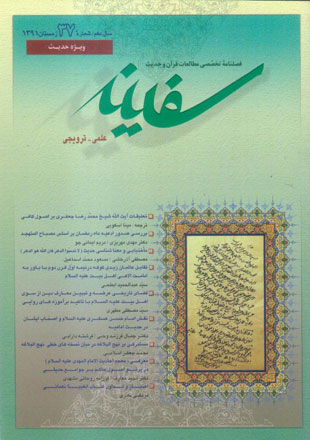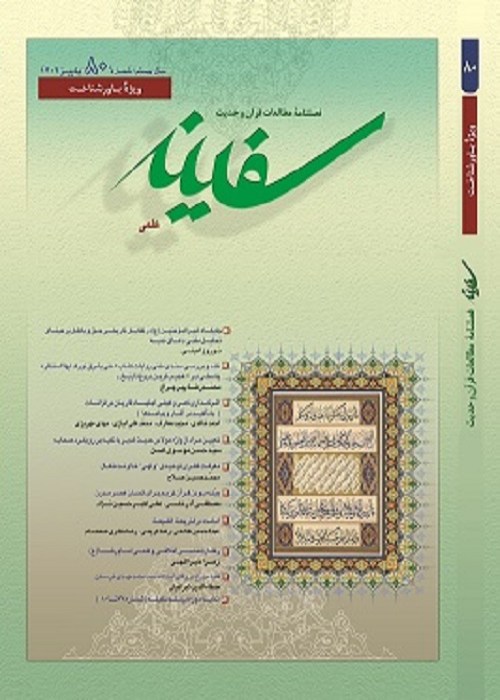فهرست مطالب

نشریه سفینه
پیاپی 37 (زمستان 1391)
- ویژه حدیث
- 196 صفحه،
- تاریخ انتشار: 1391/12/20
- تعداد عناوین: 11
-
-
صفحه 5
- مقالات
-
صفحه 11پیشتر در شماره های 19، 20، 22، 23، 24، 25، 27 و 28 سفینه، ترجمه بخشهایی از تعلیقاتی که مرحوم آیت الله شیخ محمدرضا جعفری نجفی بر ترجمه انگلیسی اصول کافی نوشته بود، به نظر خوانندگان رسید. این تعلیقات به ترتیب ابواب کتاب الحجه عرضه شده است؛ اما یک بخش از این نوشتارها باقی مانده است که در ترتیب یاد شده، باید میان مطالب شماره 19 و 20 قرار می گرفت.
توضیح مفید اینکه بنیاد فرهنگی جعفری که در زمان حیات آن علامه محقق فقید تشکیل شده و متولی تدوین و نشر آثار ایشان است نشر مجموعه کامل این تعلیقات را در یک مجلد مستقل در نظر دارد. امید است این کتاب زودتر انتشار یابد.
-
صفحه 21کتاب مصباح المتهجد نخستین کتاب جامع و روشمند در زمینه گردآوری کتاب ادعیه شیعی به شمار می رود. در این کتاب ادعیه ماه رمضان از میان ماه های قمری جایگاه ویژه ای دارد. انتخاب نه دعا از ادعیه ماه رمضان، و تحلیل آن از نظر سند بر اساس کتاب مصباح، محور این نوشتار است. ادعیه مذکور به علت مرسل بودن در کتاب مصباح، در مهم ترین کتابهای معتبر شیعه مورد بررسی قرار گرفت. با بررسی اعتبار سند و راویان، از مجموعه دعاها، شش دعا با دلایل ضعیف بودن راوی، موقوف و مرفوع و یا مرسل بودن، باعث ضعف سند گردید؛ که این ضعف را کثرت نقل، متنی محکم و متین که عدم مغایرت با قرآن کریم و احادیث و سیره قطعی معصوم 7 را شامل می شود، جبران کرده است.
کلیدواژگان: دعا، رمضان، مصباح المتهجد، صدور دعا -
صفحه 47حدیث «لا تسبوا الدهر فإن الله هو الدهر» یکی از احادیث متشابه است که در منابع معتبر اهل سنت، مانند صحیحین، روایت شده؛ اما در منابع شیعه، صرفا جهت تبیین و تحلیل آمده و سندی برای آن از سوی محدثان شیعه نقل نشده است. البته روایاتی شبیه به آن در منابع شیعی قابل ملاحظه است. همین روایات، کمک شایانی در فهم معنای حدیث مورد نظر می کند. با توجه به آیات قرآن و آموزه های معصومان: ، مقصود از این حدیث، آن است که امور عالم تکوین را که همگی تحت قدرت خدا قرار دارد، نباید به غیر او نسبت داد.
کلیدواژگان: ماخذیابی، سب، دهر، عالم تکوین -
صفحه 58در نیمه اول قرن دوم، جریان علمی و معرفتی زیدی در کوفه فعال و تاثیرگذار شد. برخی شخصیات مهم این جریان در درس صادقین شرکت می کردند، ولی نسبت به امامت ایشان تردیدهایی ابراز می نمودند و علم ایشان را کسبی می دانستند. آنان امامت را نیز برای اهل سیف شایسته می دانستند. متقابلا اهل بیت نیز تلاش می کردند که موضع خود را نسبت به این گروه برای شیعیان کوفه تبیین و با مراعات جنبه های تقیه از آسیبهای علمی ایشان بر شیعیان جلوگیری کنند.
کلیدواژگان: علم امام، امامت الاهی، زیدیه، بتریه، فقهای قرن دوم، کوفه - بخش ویژه
- اسناد و متون
- گزارش و معرفی
-
صفحه 175
- چکیده عربی
-
صفحه 188
-
Page 21The book of Mesbah al-motehajjed is the first comprehensive and methodological book on compiling praying books of Shia. In this book the prayers of Ramedan have a significant place among all lunar month's prayers. In the present article 9 prayers of Ramadan prayers and their evaluation document-wise according to the mentioned book has been offered. among the prayers, the six prayers due to their weak narrators, or etc. Lacks strong authenticity. Though this weakness has been covered by the frequent narrations of them, the compatibility with Quran and traditions and the life style of the infallibles.
-
Page 47This hadith is one of the Motashabeh Hadiths which has been also narrated in the authentic sources of Sunnite like Sehhihin. But in Shia sources it has been narrated witout any Shia-document support. Of course there exists similar shia traditions to this tradition. These similar traditions are a great help to comprehend the meaning of this tradition better. According to the verses of holy Quran and teachings of the infallibles we can infer from this tradition that all affairs of the world which are under His Power should not be allocated to anyone else.
-
Page 58In the first half of second century the scientific and spiritual school of Zeidis in Kofa gew. Some important figures of this school took part in Sadeghin's lesson. But they doubted imamat's of infallibls, knowing their knowledge and wisdom learned and not in born. They knew imamat suitable for Saif group, too. Ahlul Bayt did their best to clarify their stance regarding this issue to Shias of Kofa, while keeping the prudency of Taghiyya preventing the negative aspects of that attitude to Shia.
-
Page 93The explanation of Shia teachings which are derived from Quran and Sunnah demands a prepared situation which can be formed by the influential historical factors such as politics, society, culture, and economy. A look at the impact of these influential factors made (on the way of offering Shia's religious view point and its clarification) in different eras of infallibles, without any change in their principles can be a proof of this impact. The present article through a comparative study of teachings of infallibles based on Ahlul bayt's traditions aims at declaring the impact of the mentioned factors. In this way while answering some questions of historical religious phenomenon, it also depicts the process of it before Ghiba as it has in teachings of Ahlul Bayt.
-
Page 122The household of the holy Prophet, based on his advice, alongside the holy Quran, is the best reference whom God appointed them to lead Muslims after the holy Prophet. Imam Hassan Askari is the eleventh imam who took the responsibility of leading Muslims. This article aims at picturing the political and social atmosphere of his time as significant factors in the content of traditions, and also the way of spreading the traditions. In the present article we also talk about the ways of narrating them, and the role of his companions in reserving and spreading the traditions, introducing the traditions schools which were welcomed in his time, and we will review the works related to this imam.
-
Page 158"Traditions encyclopedias" are comprehensive collections with different benefits which religious scholars working on traditions to subject-wise collect and classify traditions of infallibles to meet various growing needs are turning to them. These collections are in fact a kind of tradition works called " Jame' Hadith", dating back to the late 2nd century. The traditions collector were always interested in gathering infallible's traditions; sometimes they have done this on a specific subject. Therefore, these encyclopedias are sometimes called " comprehensive" and sometimes " partial". The tradition scholars regard different factors in reviewing these encyclopedias. In the present article, the encyclopedia of imam Mahdi has been reviewed according to those different factors.
-
Page 175The present article aims at reviewing the authenticity of the book "al-Ghiba" and its frequaltly narration Among Shia. It has been shown in this article that the very fundamental goals of Nomani in writing his book Al-Ghiba was to prove the credibility of the belief to the twelve imams and the absence of imam Mahdi in infallibles traditions. He used several factors to prove these two subjects such as the authenticity of the narrators of these traditions regarding these two topics, the frequent ways of narrating them, their credibility with regard to logical and Quranic reasons. Besides this, Nomani asserted that he chose those traditions which can be related to infallibles. The authenticity of the traditions of Al-Ghiba concerning these two subjects strike through the theory of the incredibility of infallibles or Imamiye's tradition's borrowing from Vaghefe in the subject of Ghiba.


